Lewin Benjamin (ed.) Genes IX
Подождите немного. Документ загружается.

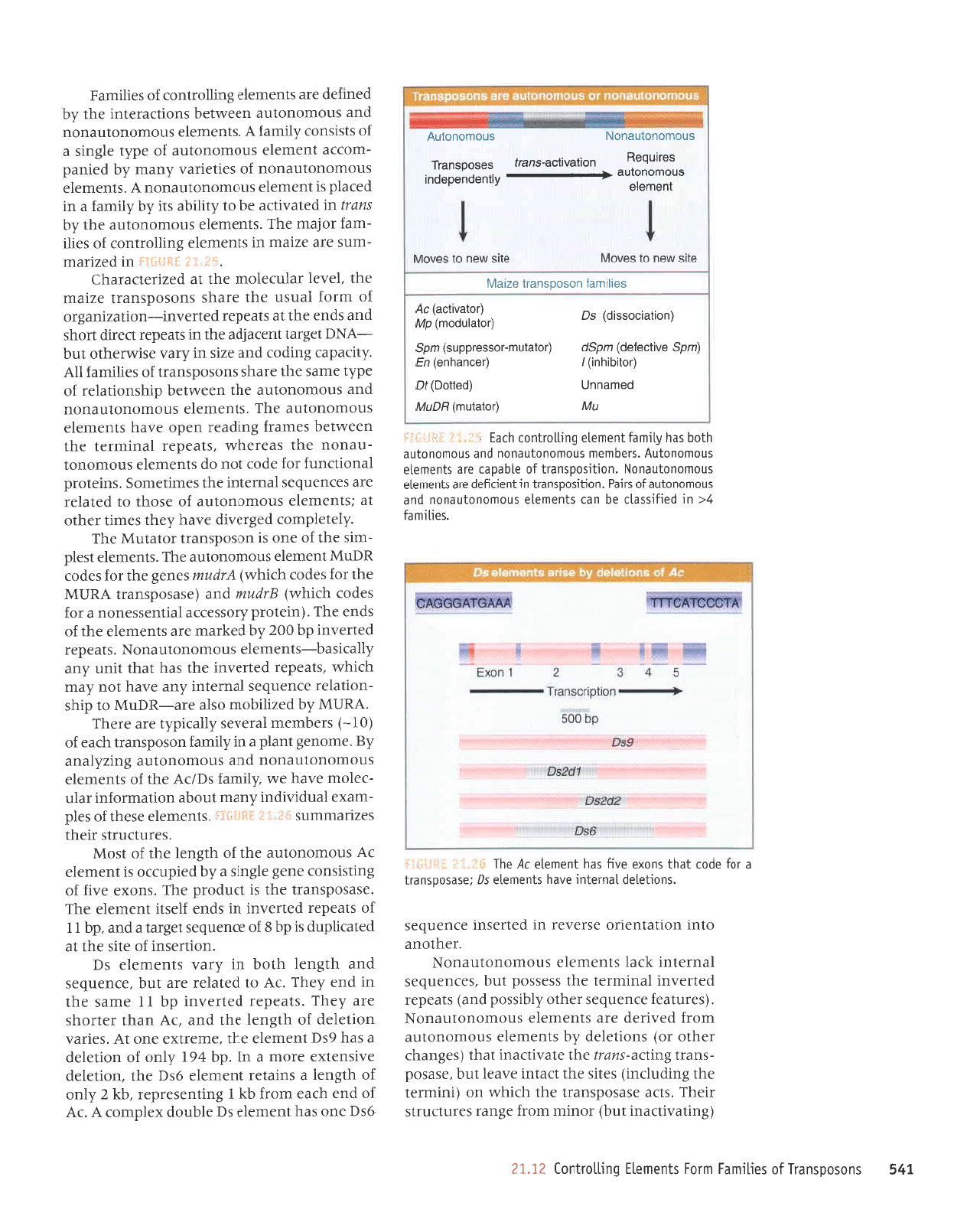
rr9
suosodsuPlf
Jo
sarlrupl
uuol sluauall burllolluol
ZI'IZ
(3une.a.rDeu1
lnq)
rourur
uror;
a8uer saJntJnJls
JIJqI
'spe
asesodsuerl arp
qJrqM uo
(turural
aql Surpnpur) salrs Jqt
petur
aleel
lnq
'asesod
-suert
Surlre
-suou
erlt alenrlf,pur
teqt
(sa8ueqr
raqto ro) suorlelep ,{.q sluaruala sno[rouolne
ruoJJ
peArJJp
JJe sluauJlJ snoruouolneuoN
'(sarnlea;
aruanbas raqto Llqrssod
pue)
steadar
pJuJ^ur
IeurrurJl
aql
ssassod
lnq
'saruanbas
IeUJJIUI
>lrel
sluaurJIJ snoruouolneuoN
rJqloue
olur uorteluerJo asreAJJ ur
pelJJSuI
aluanbas
'suoqalap
lPulolur
a^Pq sluaulele
s0 lasPsodsuell
P .loj opol
leql
suoxe eA$ seLl
lueuala
,7 091
,,;'i
r.l
ir.iiri:;j,:j
'sarlrruPJ
?<
ur
pagrssPlr
0q uPl sluauala
snououolneuou
pue
sn0uouolne
J0
sJred
'uoqrsodsuPrl
uL
luoDgap
ale
sluaualo
snououolneu0N
'uorlrsodsuPll
J0
alqPdPl
arP sluaualo
sn0urouolnv's.roquau snououolnPuou
puP
snou0uoJnP
qloq
sPq [1Lue1
luaLuale
6urllorluor
9]Pl
,,t..
I
::ijililii
9so
auo
seq
IUJIuJIJ
sO Jlqnop
xJloluol
v'JY
Jo
puJ qJpa ruorJ
q>1
1
Surtuasardar
'q>1
g
Lluo
yo
qr8ual
p
suretar
lueuelJ
9so
aql
'uollalap
elrsuatxa
JJour e
q
'dq
761
,(1uo
Jo
uollJlap
e seq
6s(
luJruJle
aql
'aruJrlxa
euo
lY
'sJIrPA
uorlJlap
10
ql3ua1
aql
pue
'rY
ueql Jauoqs
are
.daq1
'steadar
pauJAuI
dq
11
arues
aqt
ur
puJ
z(aq1
'ry
ot
peleleJ
JJe
lnq
'atuanbas
pue
qr8ual qloq uI .,{re.t stuaruJle
sO
'uonJJSUr
JO
JllS
Jql
1e
palerrldnp sr dq
g
yo
aJuJnbes ::8rc|e
pue'dq
11
1o
steadar
peuelul
uI spue
JIJS1I
lueualJ
JqJ
'asesodsuerl
Jql sI
pnpold
aql
'suoxJ
aAIJ
Jo
Surlsrsuor
aua8
a13uts e
^dq
pardntro sI
luJruela
JV snourouolne
Jqt
;o
ql3ua1
eql
Jo
tsow
'sJJnlJnrls
JrJql
s azlJeununs'i.!'t'
i.
il'*
ij
i'1
13].
j'
slueluelJ
as aql
;o
s ald
-ruexJ
pnprnrpur Lueru
lnoqe
uoIleIuJoJuI
reln
-)Jloru
aleq JM
,{.puey
sO/Jv eql
Jo
slueuJlJ
snourouolneuou
pup
snoruouolne
8utz,{1eue
.{g
'auoua8
lue1d
e ur
Lpue; uosodsuert
qtea;o
(91-)
sraqruJlx
IeJJAJs
Llertdr(1
aJP Jreql
'VU1W.{q
pazrlqoru
osle
rrp-Uqnry
ot drqs
-uollelJr
aruanbas
IpuJJlul(ue
a^leq
lou
.{eru
qJIqM
'steadar
pJuJ^ur
Jqt
spq
teqt rpn
,{ue
^dlerrseq-sluJruela
snourouotneuop'sleada.r
pJurnur
dq
OOZ
Lq
palteru
ere
stuaruelJ aql
Jo
spue aqJ
'(uratord
.,{-rossale
lelluessJuou
e Jo}
srpoJ
qJrqm\
gtpnw
pue
(asesodsuert
YU1I4
aql roJ
sapoJ
qllqMl
yrynw
saua8
aql roJ sepo)
U61nW
lueuJIJ
snourouolne
JqJ's1uaua1a
1sa1d
-urs
Jql
Jo
Juo
sr uosodsuell
rolelnw JqJ
'zllataldruor
pa8rarup a,teq
,laqt sJtull Jaqlo
le
lsluJurJlJ snoruouolne
Jo
esoql
ol
pelelJJ
arB saluanbas
IeuJJluI
aq1
sa[Illauog
'sulalord
IeuorpunJ
JoJ apol
lou
op
slueurelJ
snourouol
-neuou
aql
seeJeqm
'sleadar
IPuIuJel
eq1
ueaMlJq
sauerJ
Surpear
uado
azr,eq slueluelJ
snourouolne
3qJ'slueIuala
snoIuouolneuou
pup
snoruouolne
eql
uaeMlJq
dtqsuottela;
;o
ad.dl arues
eql aJprls
suosodsuBrl
Jo
SJIIIIUPJ
IIY
'Lloeder
Surpor
pue
JZIs ut
Lren aslmJaqlo
lnq
-vNO
la8ret tuarelpe
aql
ur stBadar
Darlp uoqs
pue
spua
aql
le
steadal
pJuenul-uotleztue8ro
Jo
ruJoJ
Iensn
eql
JJeqs
suosodsuerl
JZIPIU
aql
'lJ^al
J€lnJJIour
eq1
le
pJZIJeperPq)
'i!;1',:.i:
]S*:::-s
uI
pJZIIPUI
-urns
eJe JZIeru
uI sluetuala
Suqlorluor
Jo
sJITI
-rue;
roferu aqJ
'sluaruJla
snououolne
aqr
.dq
su2tl ur
pele^rlJe eq or
,(rq1qe s1r
.dq .dltuey
e ut
pareld sr
lueruelJ
snourouolneuou
Y
'sluaruele
snourouolnpuou
Jo
sellalJen
.dueru Lq
paued
-ruoJJe
luJlrrale
snourouolne
yo
adr(1
a13uts e
Jo
slsrsuoJ
Lgutey
V
'sluaurelJ
snourouolneuou
pue
Snoulouolne
uJJMleq
suolllPJelut
aql
,{q
peu+ep
ale
sluerualJ
3u11or1uor
Jo
seITIIueJ
nw
uolP$w)
aonw
peureuun
(patoo)tO
uoilqlqu!) /
(racueLlue) u3
(u;dganrlcelep)urdgp
Qolelnu-.rosselddns)u.tdg
(uorlelcosslp)
sO
(rotelnpou)
d/V
(rolenrlce)
cy
sarlrurel uosodsuerl azreyl
elrs Meu ol se^or\l olrs
n au ol
9a
onl
luourelo
snou-louolnp
<-
{PuaPuedaPut
-
ilil;
-
uorle^rlcesue;l
sesodsue4
snououolneuoN
snoulouolnv
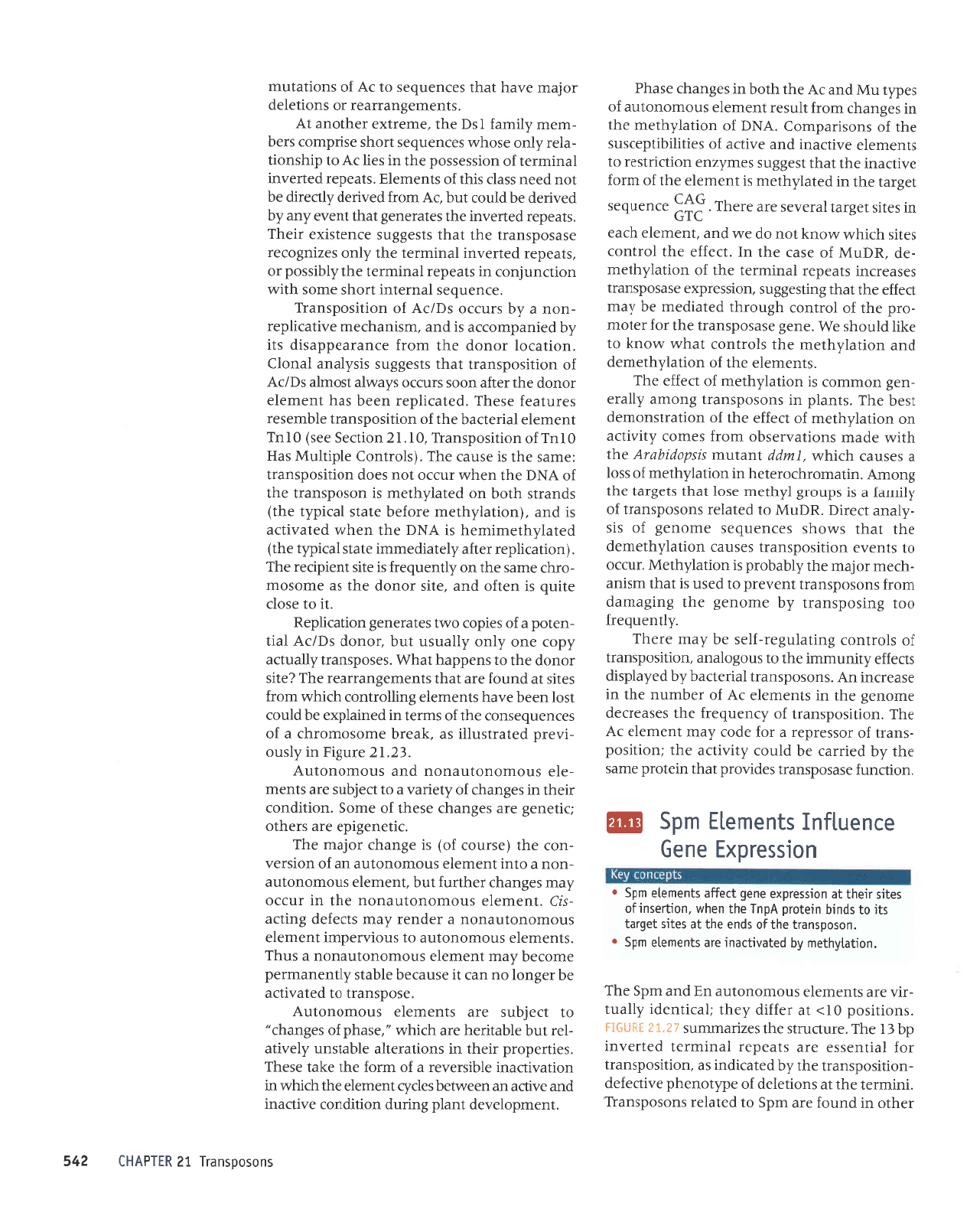
rJqlo
ur
punoJ
JJp
ruds
ol
peleler
suosodsue.\L
'rurrrrJal
aql
lp
suorlJlJp
Jo
eddloueqd
a^rDaJep
-uortrsodsuerl
Jql ^q
pateJrpur
se
'uolusodsuerl
roJ
lerluessJ
eJp sleJder
IpuruJel
pJuJAur
dq
gt
aql'JrnlJnrts
Jql sJzueuruns
te'td
lufllll
'suotttsod
0I>
te
rayyrp daqr llelrtuJpr
,{11en1
-JrA
eJe sluJruJIJ
snoruouolne
ug
pup
rud5
aq;
'uoqelr\q1aru
l\q pele,rrlreur
ale
quaurale
ud5
e
'uosodsuell
oql
Jo
spue aq1
1e
salrs
1e6re1
slr 01 spurq
uralord
ydul
aql ueq/vl
'uoqlasur
Jo
selrs
.lroql
1e
uorssatdxe
auab
page
sluauala
ud5
r
uorssajdxl
auag
aluanuul
quauall
Luds
@
'uorDunJ
asesodsuerl
sapno;d
1eq]
ulal0rd arues
Jql ^q
pJIJJeJ
eq
plnoJ
,{trnrlre
aqt luorlrsod
-suerl
Jo
rossardar
e roJ
epoJ ,{.eur
luaruala
ry
JqJ
'uorlrsodsuerl
yo
l:uanbarJ
Jr{l sJSpaJJep
Jruoua8 aqt
ul sluaurela
JV
Jo
Jequrnu
Jqt ur
aseeJf,ur uy'suosodsuprt
lerralJpq
dq
pa,{eldsrp
sDJJJa rblunururl
aql ot
snoSolpue
'uorlrsodsuerl
Jo
slorluol
Surleln8ar-ylJS
eq Leru
araql_
'AIluJnDJrJ
oot
Sulsodsuert
,(q
aruoua8
eql SurSpuep
ruor; suosodsueJl
lualerd
ol
pasn
sr
leql
rusrup
-qraru
roleur
aqr.{lqeqord
sr uoqeldqlaw
'rnJJo
01 sluJAJ
uorlrsodsuerl
sasnp)
uorlelLqlauap
aql
lpq1
sMoqs
saruanbas
Jruoua8
Jo
srs
-[1eue
r)aJI(
'u(nw
ol
pa]elJr
suosodsuerl
yo
,{gure;
e sr sdnor8
ldqraru
esol
leqt
sla8rel
aq1
Suoury
'urleruoJqJoJelaq
ur
uorlell.qtaur
yo
ssol
p
sasnpJ qJIqM
'tutpp
luerrr;u
stsdoptqaty
aql
qll,lr
Jpprx
suorlpnJJsqo
uorJ
sauro) ,,hr,rrlte
uo uorlel.dqlJru
Jo
1JJJJJ
aql
Jo
uorleJlsuouep
lsaq
eqJ
'slueld
ur
suosodsue;1
Suorue
,{11eta
-ua8
uoruruot
sr uorlel^,{qtaru
Jo
paJJe
eqJ
'stuJtuJle
Jql
Jo
uorlpl,{qlauap
pue
uorlel.dqtJru
Jqt
sloJtuo)
tpqM
Mou>l
ol
J>lrI
plnoqs
a6'aua8
asesodsuert
aql JoJ Jatoru
-ord
aql
Jo Iortuol
q8norql
patprpJru
aq..ieu
DJJJJ
aql
leqt
8unsa33ns
'uorssardxa
asesodsuerl
seseaJ)ur
sleadar
leurrrrJal
aqt
Jo
uouel.,(qtau
-Jp
'u(Inw
Jo
sseJ
Jql uI
'DaJJJ
rql
Iorluol
salrs
q)rql!l.
.&tOu>I
lou
op e^t
pue
/lualuala
qtee
uI serrs
ra8:el
pranas
arp rrrqJ'
?*?
,r,nnn*
JVJ
la8rel
aql ur
pa1e1.{qlau
sr
lueuale
eqt
Jo
ruroJ
alrlJeur
eql
leql lsaSSns
saur,{zua
uorlJrJlser
ol
slueruJle
anrlJpur pue
Jlrl)p
Jo
sarlrlrqrlda:sns
erp
Jo
suosrredruo3
'VNq
Jo
uortelAqtaru
aql
ur sa8ueqr
uorJ
llnseJ
luJruJla
snoruouolne
Jo
sadz(1 nry
pue
JV ar11
qloq
ur
sa8ueql
aseq4
suosoosuPlf
Iz
u:lldvHl
zrg
'luaurdolaaap
tueld
Suunp
uourpuoJ JlrlJpur
prrp
JAEJe rrp
uaaaqaq sJIJ,b
luaruala
Jql
Wr-qM
rrl
UOI]PAIIf,PUI
JIqISIAAAJ
P
JO
IIIJO} Eq1 EIE1 ASJqJ
'sauradord
JrJql
ul suorlpJellp Jlqelsun ,{1a,Lr1e
-lar
1nq
alqptrJaq
are r{JrqM
,,'aseqd;o
sa8ueqr,,
01
DJfqns
aJe stuaurala
snoruouolnv
'asodsuPJl
01
palP^pJe
aq ra3uo1
ou upJ
1I
asnplaq
a1qe1s
z(lluaueurrad
aluo)aq deu
luarualJ
snoruouolnpuou
e snqJ
'sluaruJla
snourouolne ol snoraradurl
luaruJlJ
snoruouolnpuou
e JJpuJr deru
snalap Surlre
-slJ
'lUaruJIJ
SnOrUOUOlneUOu eql
Ur
Jnf,JO
leur
sa8ueq)
JaqunJ
lnq
'luarualJ
snourouolne
-uou
P olur
luaruJla
snotuouolnp ue
Jo
uorsJe^
-uoJ
Jqt
(asrnor
;o)
sr
aSueql roleru aq1
'tpaua8rda
Jrp sraqlo
jrrtaua8
are sa8ueqr
aseql
Jo
Jruos
'uorlrpuoJ
Jleql ur
sa8ueqr
yo,fuarrerr
e
ol
Dalqns
eJp sluJrrr
-elJ
snoluouolnpuou
pup
snououolnv
'€Z'IZ
arnSrg ur Llsno
-raard
paleJlsnllr
se
'>leeJq
eruosoruoJqJ
p
Jo
saruanbasuoJ
eql
Jo
sruJal ur
peureldxa
aq
ppor
lsol
uaJq
aneq slueuala EurlorluoJ
qJrqM
rrroJJ
setrs
lp
punoJ
alp
tpqt
sluarue8ueJJpal JqJ
ealrs
Jouop aql
ot suaddeq
lpq6
'sasodsuel
[fipnlJe
Ldor
auo z(1uo ,{11ensn
lnq
Touop
sO/JV
Ipll
-uatod
e;o
sardor oml sJleJeua8
uoperlldag
'u
ol
asolJ
alrnb
sr uJlJo
pup
'Jlls
rouop Jqt se
Jrrrosour
-oJqJ
arues
aql uo ^puenbary
st alrs
luardnar
aql
'(uorlerrldar
raqe ,{.lalerparxrur
Jlpls
prrddr
aqr)
patpl^qlatururaq
sr
VNO
eq1
uJqM
pelelrlJe
sI
pup
'(uor1e1z(qtaru
aJoJaq
arers
1errd,{1
aq1)
spuerls
q10q
uo
perel^qleu
sr uosodsuerl
aq1
Jo
VNC
eql ueqm rnJJo
lou
sJop uoursodsuBrl
:aures
eql sr JSne)
aq;'(s1ortuo3
a1du1ny,g seg
0IuJ
Jo
uorlrsodsue-11'61'
lZuonJJS
:as)
g1u1
lueuale
pueppq
Jql
Jo
uoursodsuert
alquasaJ
seJnlpeJ
asaqJ
'palerrldar
uaaq
seq
luJruJla
rouop
aql rJUe
uoos sJnJJo
s,{e,r,r1e
}souqp
s(/JV
yo
uorlrsodsupJl
leqt
stsaSSns srsz(1eue
Ieuol)
'uortPJol
Jouop
Jq1 tuoJJ aruereaddesrp
sll
,{q
parueduroJJp
sr
pup
'ursrueqraru
a,rrletrldar
-uou
e dq srnrlo
sq/Jv
yo
uorlrsodsuerl
'aJuanbas
IeuJatq
uoqs
auos
qlrM
uortJunluof,
ur sleadar
IeurruJel
eql ^lqISSod
Jo
'slEJdJJ
pJUJ^ur
lpurruJJl
aqf ,{.po sazruSolar
asesodsuB4
aql
leqt
stsaSSns aJuJtsrxa
Jrer{J
'sleada;
pJua^ul
eql seleJJuJE
lpql 1ua^J
,(u€
dq
pe^uJp
Jq
plnoJ
lnq
'tV
ruoJJ
pJ^rJJp
z(1uarp
aq
lou
peau
sselJ
srql
Jo
sluJruJIE
'sleadar
p:uanur
IpurruJJl
Jo
uorssassod
aql ut
saq ty o1 drqsuoll
-e1ar,{po
asoqM
sa;uanbas
goqs
asrrdruo)
sJeq
-urJru,{.pue;
IS(
Jql'eurarlxJ
JJqloue
ly
'sluerua8uerJpeJ
Jo suorlJlap
roleur
e^eq
leql
saJuenbas ol
JV
Jo
suorlplnur
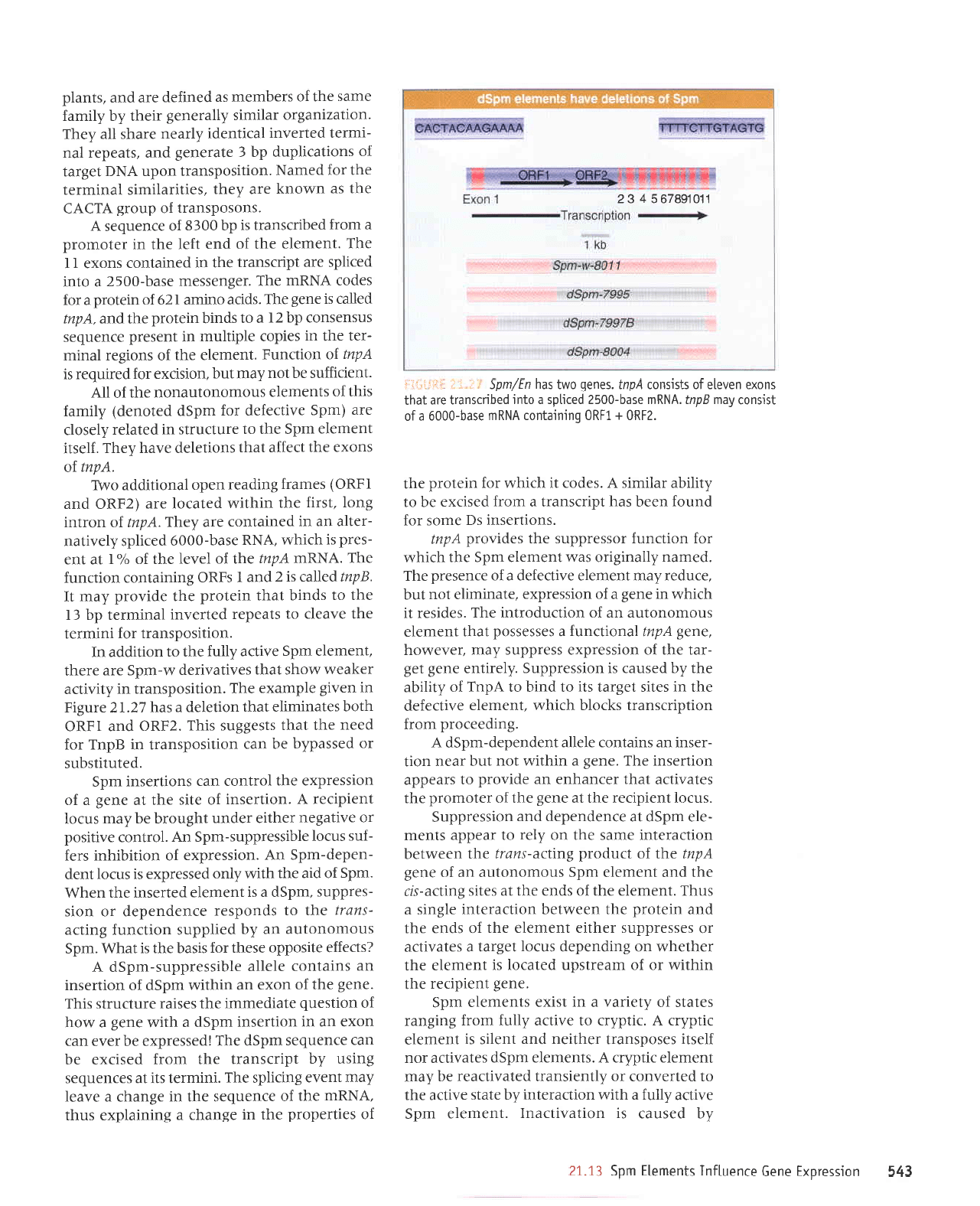
E?9
uorssaloxl
aua9 aluanuul
sluaulall uos
EI'IZ
Lq
pasner
sr uorlenrllpul
'luJruela
rudg
anrpe.{1n; e
qlrM
uorlJprJlur.ri.q a1e1s e^rlJe
eql
01
pJlJaAuoJ
Jo ^lluarsueJl
pJle^rlree:
aq ,{.eru
luaruJlJ
JItd^JJ
V'sluJrrrJle
ud5p
sale,lrt)e
rou
;1as1r
sasodsueJl JJqlrJu
pue
tuJlrs
sr
tuJuala
rud.{n
V
'rrtdzfur
ot elrtJp,{11n; urory
Sur8uer
sJlels
Jo
[1arre,t
e ur
tsrxJ
sluaruala
urd5
'aua8
luardoer
Jql
urqtrM ro
Jo
rxpJrlsdn
paterol
sr
tuJruJIJ
aq1
lJqteqM uo Surpuadap snJol
ta8rct
e sJtpnrtJe
ro sassa.rddns rJqtre
tuJruJla
Jqt
Io
spua
Jq1
pue
uralo:d Jq] ueeMlJq uorlJpJJlur
a18uts
e
snql'tuJrualJ aql
Jo
spuJ Jql
lp
setrs Suwe-sn
eql
pue
luJruelJ
rudg snoruouolne ue
;o
aua8
ydul
aql
1o
trnpord
8u\te-suau aqt ueJMtaq
uorlf,erJlur
Jrups eql uo
Llar
ol
readde sluJru
-a1a
rud5p
1e
aruapuadJp
pup
uorssarddn5
'snro1
luardrJJJ
JrIl
le
aua8 Jql
Jo
JJtoruord
aqt
selelrlJe
lpql
rJJuer{ua up Jprlord ol sreadde
uoruJsur aq1
'aua8
e urqlru
lou lnq
Jeeu
uoll
-Jesur
ue suretuo)
JIJIIe
tuJpuJdap-rudgp
y
'Surpaarord
ruor;
uortdrnsuert s>lJolq
q)lqM'tuJruJIJ
JATpJJJp
eqt ur setrs
taSret
slr ot
pulq
or
ydul
yo
,{llltee
aql ,(q
pJsnef,
sr
uorssarddn5
'd1arr1ua
aua8
la8
-lel
Jql
;o
uotssardxa ssarddns
.{eur
'ra.La,rtoq
'aua?
ydul
leuorpunl
e sassassod
lpqt
luJruela
snoruouolnp
ue
Jo
uorlJnpoJlur eqJ
'sJprsar
1r
qrlr{M
ur aua8 e
1o
uorssardxJ
'Jlpururrla
tou lnq
'arnpar
Leu
lueuale
JATIJJJJp e;o aruasard
aq1
'paueu.{.11eur8rro
sem
luJruelJ
rudg aql
qJIqM
JoJ uortrunJ rossarddns aqt sapuord
yduT
'suoruJsur
s( eluos
JoJ
punoJ
ueJq seq
ldrnsuerl
p
uoJJ
pesrJxa
eq ol
,(t1gqe relrrurs
V
'sapoJ
ll
qJrqM
roy uralord
aql
'zluo
+
lluo
bututeluol
vNUtu
asPq-0009
e
J0
lsrsuor
r\eu
gdul
'y1i1gru
aspq-0OgZ
parqds
e olur
poqulsuerl
orP
leql
suoxa ua^oloJo slsrsuol
ydu;'sauab
oml
spq uj/wd5
.;r lii ;;J;:ij,1:il
yo
saluadord
eqt
ur a8uuqr
e Suruteldxa snqt
'VNUru
eqt
Jo
aJuenbas
aql ut a8ueqr
e JAPeI
Leru
tuana
SuDITds
JqI
'tutrurJl
slt
le
saruanbas
Sursn
,{q
tdr.rrsuerl
Jql uoJJ
pJSIJXJ
aq
uer aruenbas
rudgp
aq1
lpassardxa
aq raAJ
ue)
uoxJ
up ur
uoruJsul
rudgp e
qlprzr
aua8 e .l.roq
1o
uorlsanb
elelparurul
aql
sasIPJ ernlf,nJls
sIqJ
'aua8
aqt
Jo
uoxa
up uIqlIM
rudgp
yo
uoluJsul
up suretuor
JIJIIB
elqlssarddns-rudgp
y
ZSDaJIJ
alrsoddo
Jseqt
roJ sISPq JI{t
s1
req14'utdg
snourouotne
ue
Lq
parlddns uollf,unJ Surlte
-suou
erqt ot
spuodsar
aruapuadap
Jo uoIS
-sarddns
'udSp
e sI
tueurelJ
pJuesul
Jql
uJqM
'rudg
yo
pre
eql
qllm IIuo
passardxa sI snJol
luep
-uadap-rudg
uy
'uorssardxJ
Jo
uolllqlqul
sJeJ
-Jns
snJol alqrssarddns-rudg
uy'lorluoJ
anplsod
ro arrrleSau
reqllJ
Jepun
rqSno:q
aq,{eu
snrol
luardnar
V
'uoruesul
Jo
alIS Jql
lP
aua8 e
;o
uorssardxa
Jql
IoJluoJ
ue)
suollJJSur
rud5
'pJlnlllsqns
ro
passed.dq
eq upr
uorlrsodsue;l
ur
gdul
roy
prau
rql
teqt
slsaSSns slqJ
'ZduO
pue
IdUO
qtoq
saleululTJ
leqt
uollelep
e seq
LZ'IZ
arn8t4
ur ua,rr8
alduexa
aql
'uotltsodsueJl
ul{.lratlrB
JJ>lee,lt
,ltoqs
lpql
sJlllenrrap
.tt-rudg aJe eJJql
'tuJruJla
ruds
arrrpe
^llnJ aql ol
uolllppe uI
uorlrsodsuerl
roJ IuIIuJel
Jq1 eAeJIr
ot sleadar
peuelul
leunural
dq
51
JrIl ol
spulq
teql
utalord
aq1 apr,rord
,{.eru
lI
'gdu1pa11et
sI
Z
pue
I
sduo Surureluor
uolltunJ
eqJ
'VNUru
ydul
arp
Jo le^al
aqt
Jo
%
I
lE lua
-sa.rd
sr
qJIqM
'VNu
espq-0999
parllds
L1a,rr1eu
-rJlle
uP
ur
pJuIPlUo) are
.,{aq1
'ydu1
1o
uoJlul
3uo1
'rsr1y
eqt
UIqUM
prlProl are
(7ggg pue
ICUO)
seruprJ Supear
uado
leuotlrppe
o^q
.vaw
p
suoxJ Jql
DaJJ€
]eq]
suollrlap
a,req.daql';1astt
tuJruele
urds
aqt ol
eJnlJnJls
uI
pJlelJr
z(1asop
are
(rudg
JAItrJJap
roy
rudgp
palouap) ,{pue;
srql
Jo
sluJurele
snourouolnPuou
Jql
Jo IIY
'luJrJrJJns
aq
tou
,{eru
1nq
'uoIsDXJ
ro;
parmbar
st
vdw
lo
uorDund
'luJluale
aqt
yo
suor8ar
pulru
-Jel
Jq1 ur sardol
aldppru
ut
tuasard
aluanbas
snsuesuof,
dq
Zt
e 01 spulq
ulelotdaqlpue'ydu1
palpr
r aua8 aqJ
'splJp
ourure
179
;o
rnalord e ro;
sJpoJ
VNUrU
aq1
'ra8uasseru
JsPq-0gS2
e olul
parrlds
a;e
tdt.rrsuBrl
Jq1 ul
pJuleluoJ
suoxJ
I I
aqJ
'tuJruela
rql
Jo
pua qJI
aql
ul raloruord
e ruorJ
paqrrJsuert sl dq
00€8;o
aluanbas
y
'suosodsuerl
;o
dnor8
YJ)Y)
aql se
uMou>l
are
,{aql
'selluelltuls
IPuIrxrJl
Jql JoJ
pJrueN
'uolusodsuetl
uodn
y1trq
1a8re1
;o
suorlerlldnp
dq
€
ateraua8
pue
'sleadar
pu
-rrurel
pauJAuI
leJltuJpl{peau
areqs
1p.daq1
'uorlezrueS:o
rplltuls
dlerauaS
raqt
,{q .{puel
euPS
Jq1
Jo
sJeqruau
se
peuIJJp JJP
pue
's1ue1d
ll0t68L9
I n tz
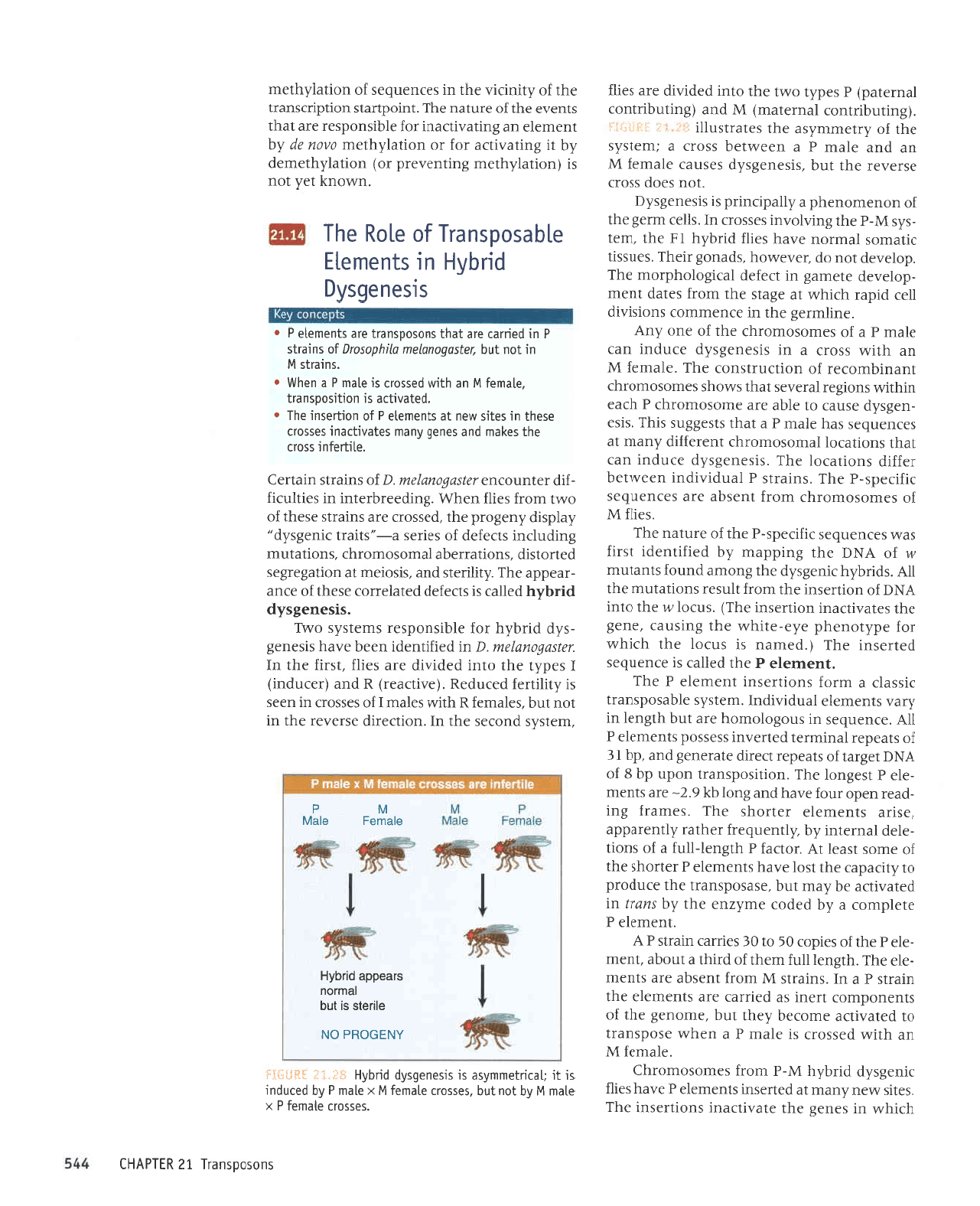
r{)lqM ur sJuJS
Jrll
ale^rlJeur
suoruesur
JqJ
'selrs
Mau ^ueu
]e
peuasur
slueruJle
d
e^eq sJru
)rua8s^p
plrq^q
W-d
ruoJJ satuosotuorq)
'alPlueJ
w
ue
qlrM pJssoJJ
sr
elelu
d
p
uaq^1.
JsodsueJl
ol
pJt€ApJe
euof,eq
,{aqt
tnq
'aruoua8
Jqt
Jo
sluauodruor
ueur
se
pJrrreJ
JJp sluJrrrJlJ
Jql
UIEJ]S
d
P UI
'SUIPJIS
W
IUOJJ
IUJSqE
EIP S]UAUI
-rle
aqJ
'qt3url
IInJ
urql
Jo
plql
e
tnoqe
'turru
-elJ
d
Jqt
Jo
sardor
gg
ol
0€
selJrpJ ureJls
d v
'luJruala
d
ataldruor e .{q
papor
aru.dzua
aqt ,(q
suoJj ur
pJtp^It)e
aq Leur
1nq
'asesodsupJt
Jql arnpord
ol
.4]neder
aql
lsol
JApq stuJruelJ
d
Jauoqs
aql
Io
aruos
tseJl
tV
'roDeJ
4
qt8ual-11nJ
e
Io
suorl
-rlJp
leurJtut,{q
.{lruanbrrJ
raqler
.dltuaredde
'JSrJp
sluaruJle
JJuor{s
JqJ'saurer;
3ur
-pear
uado
JnoJ JAeq
pue
3uo1
ql6'Z-
are sluaur
-a1a
4
tsa8uol
JqJ
'uorlrsodsuerl
uodn
dq
g
yo
ytrtrq
la8rer
yo
sleadar
Dalrp
elereua8
pue
'dq
1g
;o
sleadar
IeuIruJJl
pJuaAur
ssassod sluJuala
d
1y
'aruanbas
ur snoSolouoq
alp
tnq
qfual
ur
.,i.:en
stuaruale
Ienprnrpq'rualsLs
alqesodsuerl
Jrssel)
e ruJoJ
suorlrJsur
luJtuJIJ
d
JqJ
'luaruala
d
Jql
pellpJ
sr eluanbas
peuasur
aqJ
('peueu
sr
snJol Jqt qJrr{,rr
roJ addtouaqd
ada-a1rqM
Jql
Sursner
'aua3
ar{l sJlplrlJeur
uoruJsur
aq1)
'snro1
,4r Jql
olul
YNC
Jo
uoruasur
eql
uoJJ
tlnseJ
suorlplnu
eql
1y
'sprrqi(q
trua8sLp
aqt
Suorue
punoJ
sluelnu
/vl
Jo
vNO
aqt
Surdderu
.4.q
parJrtuapl
tsrrJ
se.tr satuanbas
rrynads-4
Jql
Jo
aJnteu
aqJ
.SJIIJ
W
Jo
seruosotuoJqJ
ruolJ
luesqe
a.re sa:uanbas
rrJtrads-4
JqJ
'sureJls
d
Ienprnrpur
uaaMlJq
rJJJrp
suortetol
ar{J
'srsauaSsLp
a)npur upJ
lpql
suorterol
IeuosotuoJqJ
tuJrJl;rp
Lueru
te
sJ)uenbJs
spq JIBIU
d
e
tpql
s1sa33ns
srqJ
.srsJ
-ua8s,{p
asnpf,
ol elqe
eJp euosoruoJr{)
d
qJeJ
ulqll,vt'
suor8ar
IerJAes
leql
suoqs
sJruosotuoJqJ
lueurquroJaJ
Jo
uorlJnllsuoJ
JqJ
'JIeuJJ
W
ue
qlrM
ssoJf,
e
ur srsaua8s.dp
arnpur uer
Jleul
d
e
Jo
sJruosoruoJq)
aqt;o
:uo Auy
'aurlura8
aql ur
eJuJururoJ
suorsrlrp
1ar
prder
qJIqM
te
J8els
Jqt uroJJ
setep
tuJru
-dolanap
atarue8
ur
pelJp
lerrSoloqdrou
aqJ
'dolanap
tou
op teAJMoq
'speuo8
JreqJ
.sanssrl
Jrleuros
Ieurou
alpq
sJrlJ
plJq^r{
I{
Jr{l
,rual
-sds
ry-4
aqt.3ur,L1o,tur
sJSSorJ
uI
's[e)
ruraS
aql
Jo
uouJtuouaqd
e [lednurrd
sr srsauaBs.dq
'lou
seop ssoJ:)
asJJAJr
aql
lnq
'srsaua8sLp
sasne)
JIeruaJ
W
up
pup
eleru
d
e ueaulJq
ssoJJ
p
lruals.{.s
aql
Jo
,{rlaruruLse
Jr{l
salerlsnlll
:j;
;.j
;iI*f-:r,;
'(8ur1nqrr1uor
puraleru)
W
pup (3ur1nqrr1uor
purared)
4
sad.{1
0^t1
eql
olur
pepr^rp
ere sarlJ
suosodsuerl
IZ
ulldvHl
'sossorl
alPuaj
d
x
aleu
6
{q
lou lnq
'sassorr
olerual
111
x
alpur
d
r{q
pernpur
sr
lr
llpluleuur{se
sL srsauabsfp
puqfig
$ri.,ii]
]Eil*i:j
'ruals^S
puoJes
eql uI
'uorl)aJrp
esJeAeJ Jr{] ur
lou lnq'saprueJ
u
qllM
sJlelu
I
Jo
sessoJJ ur uaJs
sr LlrTrual
paJnpau
'(a.trpear)
g
pue (ratnpur)
1
sed.{r Jqt otul
pJpl^lp
ere serlJ
'tsrrJ
aql uI
nlsadounlaut'C'
ur
pJrJrtuJpr
ueeq aneq srsaua8
-s,{p
prrq.{q
ro;
alqrsuodsar sruals.ds
o,l,g
'qsauaBsdp
plrq,{q pJIIp)
sr sDeJap
pJlelrrlot
JsJql
Jo
eJup
-readde
aqJ
'z{.lurrals
pup
'srsorJtrr
le
uoneBer8as
pJuolsrp'suorleJJaqe
IPuosouorqf,
'suorlelnru
Surpnpur
sDaJap
Jo
sarrJs e-,,slrert
rrua8s.dp,,
.{eldsrp
,{uaSord eqt
'pJSSor)
aJp surells eseqt
Jo
oMl IUoJJ saITJ
uJqM
'Surpaarqralur
ur sJrUnJrJ
-JIp
JJlunoluJ
Ja$D60uapw
Q
lo
surerls urelJJJ
'alrileJuI
ssot]
oql saleur pue
sauab
[ueu
salenrlreuJ
sossot]
asaql ur sel'[s Mau
t"l::"1:l:-1,.:
::i1:::l:1.1
'
palPAllrP
sr uorlrso0suPrl
'alPuroJ
[ir|
ue
qlrM pessorl
sr aleul
d
p
ua!fi\
o
'sulPrls
l^l
ur
lou
lnq
'ta1so6ouo7aw
olu.ldosotg
Jo
surplls
d
ur
pourpr
elp
lpql
su0s00suell 0.lp slueutole
I
o
srseuo6s^o
pyq^H
ur
quauoll
alqPsodsuPrf
Jo
alou aql
'u'rtou>l
le^ lou
sr
(uor1e1,{.qtaru
Surtua,Lard ro)
uor1e1,{qraurap
.dq
tr
SurlenllJe
JoJ ro uor1e1.dq1aut
onou ap Aq
luJIuJIa
ue Surlearpeur
roJ elqrsuodsar
a;e
leql
sluJAJ
eql
Jo
Jrrueu aq1
'1urod1rels
uorldrJJsueJl
aqt
yo.dlruul
eqt
q
saruanbas;o
uorlelLqtaru
ANSOOUd
ON
aluols sr
lnq
leurou
sreedde
puqrtg
aleuol alEy\c
|/\d
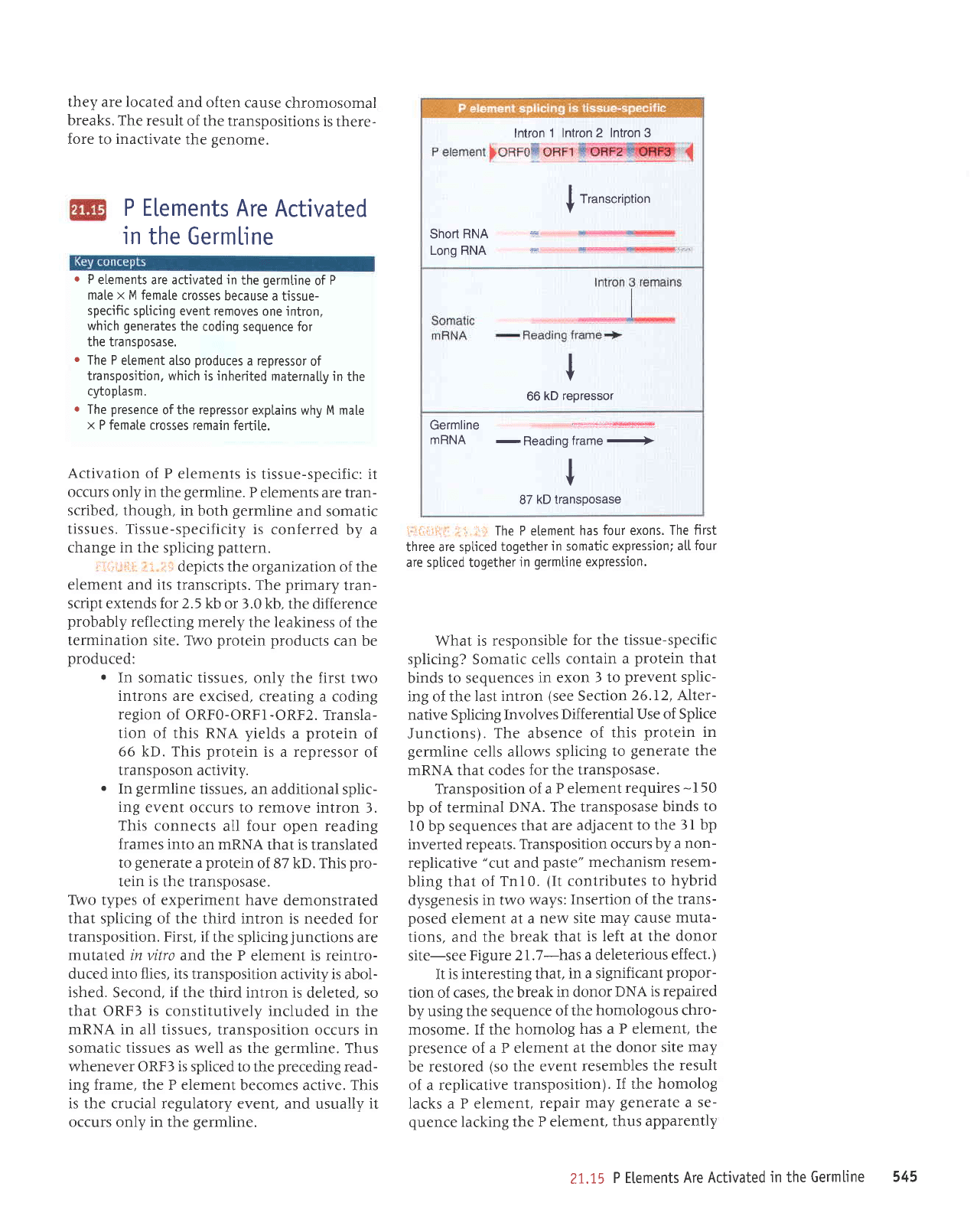
they are located
and
often cause
chromosomal
breaks.
The result
of the transpositions
is
there-
fore to inactivate
the
genome.
P Elements
Are
Activated
in
the GermLine
o
P
elements are activated in
the
germtine
of
P
male x M femate
crosses
because
a tissue-
specific
spticing event removes
one intron,
which
generates
the
coding sequence for
the transoosase.
.
The P
etement also
produces
a repressor
of
transposition, which is inherited
maternatty in
the
cytoptasm.
e
The
presence
of the
repressor
exptains why M male
x
P femate crosses remain
ferti[e.
Activation
of P
elements is
tissue-specific: it
occurs only in
the
germline.
P
elements are tran-
scribed,
though, in both
germline
and somatic
tissues. Tissue-specificity
is
conferred by a
change in
the splicing
pattern.
riiii:
riii:
,
: ; I
depicts the
organization of the
element
and
its
transcripts.
The
primary
tran-
script extends for 2.5 kb
or 3.0 kb, the
difference
probably
reflecting
merely
the leakiness of the
termination site. TWo
protein
products
can be
produced:
.
In somatic tissues,
only the first
two
introns are
excised, creating
a coding
region
of ORF0-ORFI
-ORF2.
Transla-
tion of this RNA yields
a
protein
of
66 kD. This
protein
is a repressor
o{
transposon activity.
.
In
germline
tissues, an
additional splic-
ing
event occurs
to remove intron 3.
This connects
all four
open
reading
frames
into an mRNA
that is translated
to
generate
a
protein
of 87 kD. This
pro-
tein
is
the transposase.
TWo types of experiment
have demonstrated
that
splicing of the third intron is needed for
transposition. First, if
the splicing
junctions
are
mutated
in vitro and the P
element is reintro-
duced into flies, its transposition
activity is abol-
ished.
Second,
if
the third intron is
deleted, so
that ORF3 is constitutively
included in the
mRNA in
all tissues, transposition
occurs
in
somatic tissues as well as the
germline.
Thus
whenever ORFI is
spliced to the
preceding
read-
ing frame, the P element
becomes active. This
is the crucial regulatory event,
and usually
it
occurs only in the
germline.
i,iiii.i{'11
.'
1,,:rrr The P etement
has
four
exons.
The first
three are spliced
together
in somatic expression;
at[ four
are sp[iced together
in
germtine
expression.
What
is responsible
for the tissue-specific
splicing? Somatic cells
contain
a
protein
that
binds to sequences
in exon
3 to
prevent
splic-
ing of the last
intron
(see
Section
26.I2, AIter'
native Splicing Involves
Differential
Use of Splice
Junctions).
The absence
of
this
protein
in
germline
cells
allows splicing
to
generate
the
mRNA that codes
for the transposase.
Ttansposition
of a
P element
requires
-I50
bp
of
terminal DNA.
The transposase
binds
to
l0
bp sequences
that
are adjacent
to the
3l bp
inverted repeats.
Transposition
occurs
by a non-
replicative
"cut
and
paste" mechanism
resem-
bling that of
Tnl0.
(It
contributes
to hybrid
dysgenesis
in two ways:
Insertion
of the
trans-
posed
element
at a
new site
may cause
muta-
tions, and
the break
that
is left at the
donor
site-see
Figure 21 .7-h'as
a deleterious
effect.)
It is interesting
that,
in a significant
propor-
tion of cases,
the break
in donor
DNA
is repaired
by using the sequence
of
the homologous
chro-
mosome. If the
homolog
has a P element,
the
presence
of
a P element
at
the donor site
may
be restored
(so
the event
resembles
the
result
of a replicative
transposition).
If the
homolog
lacks
a
P element,
repair
may
generate
a se-
quence
lacking the
P element,
thus apparently
I
I Transcription
V
Short RNA
.e*
Long RNA
irr
lntron
1 Intron 2 Intron 3
I
66
kD repressor
Germline
t.+-+:;5!igqFffi
mRNA
-
[ts2iing
frame 4'
I
T
Y
87
kD transposase
21..1,5
P Elements
Are Activated
in the Germline
545
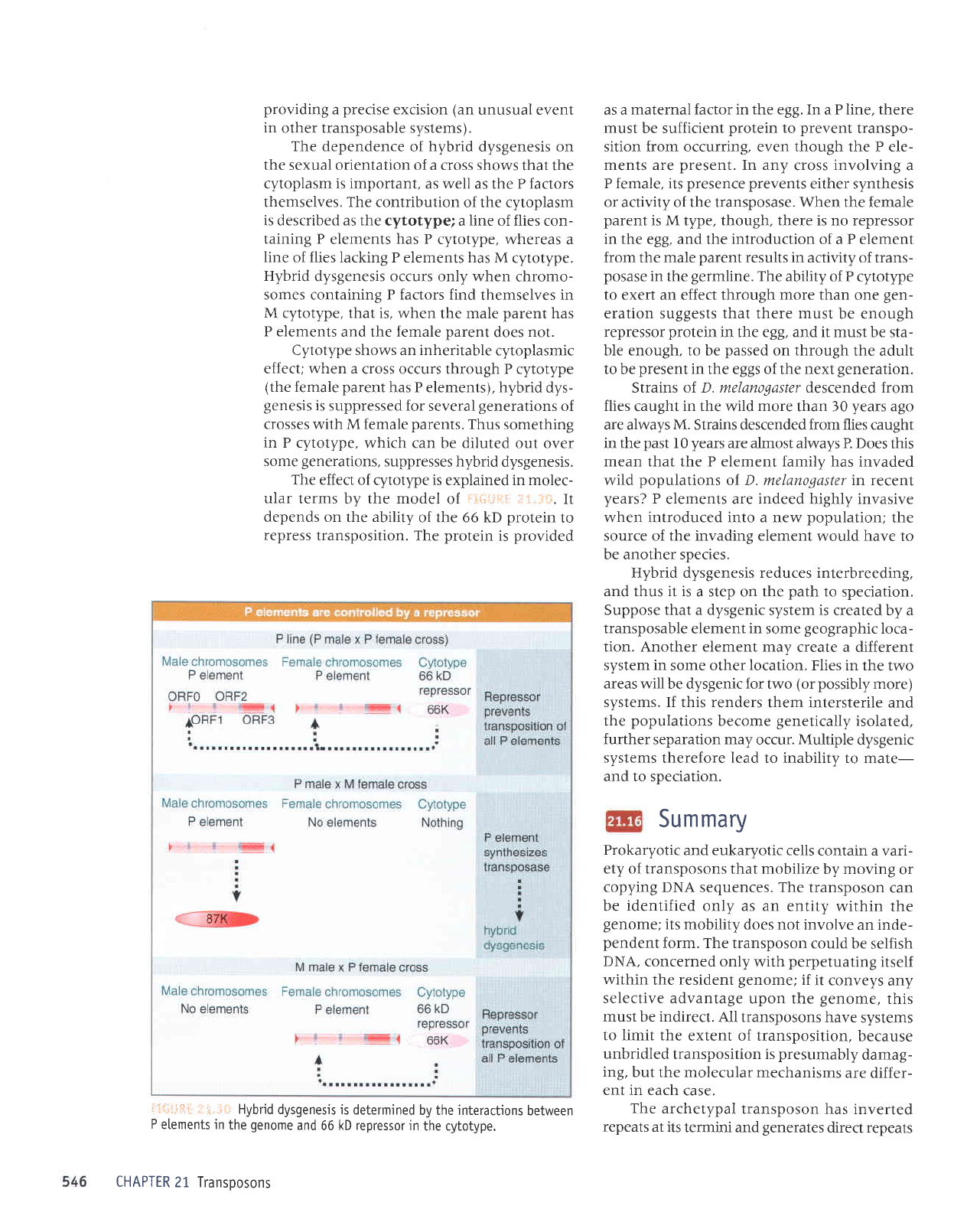
providing
a
precise
excision
(an
unusual event
in
other transposable systems).
The dependence
of
hybrid
dysgenesis on
the
sexual orientation of a cross shows
that the
cytoplasm is important, as
well
as the
P factors
themselves. The contribution
of the cytoplasm
is described as the
cytotype; a line of flies con-
taining P
elements
has
P cytotype, whereas
a
line
of flies lacking P elements has
M cytotype.
Hybrid
dysgenesis occurs only when
chromo-
somes containing P factors find
themselves in
M cytotype, that is, when
the male
parent
has
P elements
and the female
parent
does not.
Cytotype shows an inheritable
cytoplasmic
e{fect; when a
cross occurs through P cytotype
(the
female
parent
has P elements),
hybrid dys-
genesis
is suppressed for
several
generations
of
crosses with M female
parents.
Thus something
in P cytotype,
which can be diluted
out over
some
generations,
suppresses hybrid
dysgenesis.
The effect
of cytotlpe is explained in molec-
ular
terms by the model
of
ii{,i.ii:ii: .:i"-:il.
It
depends on the ability
o{ the 66 kD
protein
to
repress transposition.
The
protein
is
provided
::iliriltii
;i i.:;i;
Hybrid
dysgenesis is
determined
by the interactions
between
P
etements in
the
genome
and
66 kD
repressor
in
the cytotype.
CHAPTER
2L Transposons
as a
maternal factor in the egg. In
a
P line, there
must
be sufficient
protein
to
prevent
transpo-
sition from occurring, even though the P ele-
ments are
present.
In any
cross
involving
a
P female, its
presence prevents
either synthesis
or activity of the transposase. When the female
parent
is M type, though, there is no repressor
in the
egg, and the
introduction
of a
P
element
from the male
parent
results in activity of trans-
posase
in
the
germline.
The
ability of P cytotlpe
to exert an effect through more than
one
gen-
eration
suggests
that there must
be enough
repressor
protein
in the egg, and it must be sta-
ble enough, to be
passed
on through
the adult
to be
present
in
the eggs of the next
generation.
Strains of. D. melanogaster descended from
flies
caught
in the
wild
more
than 30
years
ago
are always M. Strains descended from flies caught
in the
past
l0
years
are almost always P. Does
this
mean that the P element family
has invaded
wild
populations
of D. melanogaster in recent
years?
P
elements are
indeed
highly invasive
when introduced into a new
population;
the
source of the invading element
would have to
be another species.
Hybrid dysgenesis reduces interbreeding,
and
thus
it is
a step on the
path
to speciation.
Suppose that a dysgenic
system is created by a
transposable
element
in
some
geographic
Ioca-
tion. Another element may
create a different
system in
some other
location.
Flies in
the two
areas will be dysgenic for two
(or
possibly
more)
systems. If this renders
them intersterile and
the
populations
become
genetically
isolated,
further separation may
occur. Multiple dysgenic
systems
therefore
lead
to inability to mate-
and to speciation.
Sum
mary
Prokaryotic
and eukaryotic cells
contain a vari-
ety of transposons that mobilize
by moving
or
copying DNA
sequences. The transposon
can
be
identified
only as an
entity within
the
genome;
its
mobility does not involve
an inde-
pendent
form. The transposon
could
be selfish
DNA,
concerned only
with
perpetuating
itself
within
the resident
genome;
if
it conveys
any
selective advantage
upon the
genome,
this
must be indirect.
All transposons
have
systems
to limit the
extent of transposition,
because
unbridled
transposition is
presumably
damag-
ing,
but the molecular
mechanisms
are differ-
ent in each
case.
The archetypal
transposon
has inverted
repeats at its
termini and
generates
direct repeats
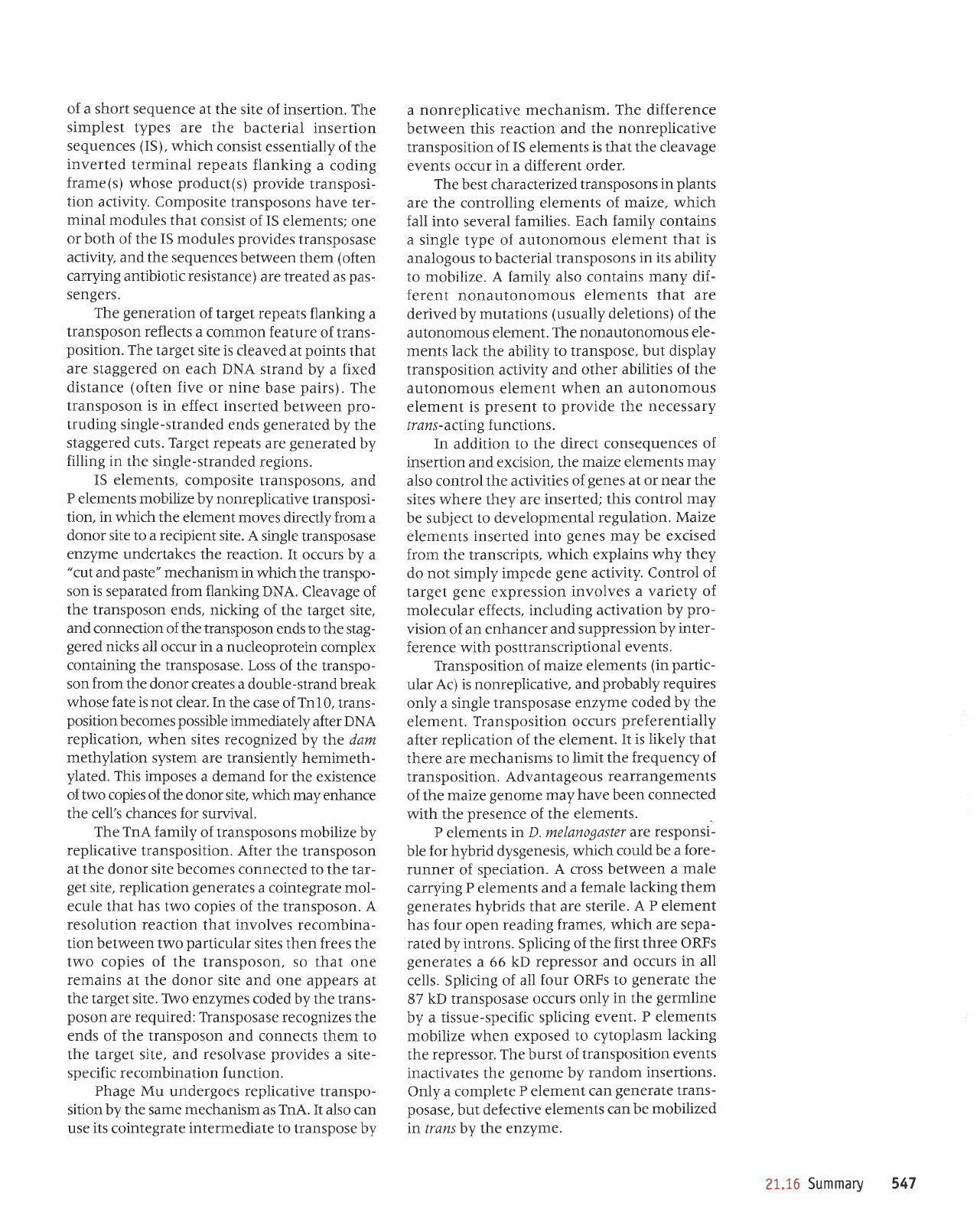
of a short sequence
at the
site of insertion.
The
simplest
types are the
bacterial
insertion
sequences
(IS),
which
consist
essentially
of the
inverted
terminal repeats
flanking
a coding
frame(s)
whose
product(s)
provide
transposi-
tion
activity. Composite
transposons
have ter-
minal modules that
consist
of
IS
elements;
one
or both
of the
IS
modules
provides
transposase
activity, and the sequences
between
them
(often
carrying
antibiotic resistance)
are treated
as
pas-
sengers.
The
generation
of target
repeats flanking
a
transposon reflects
a common feature
of trans-
position.
The target
site is cleaved
at
points
that
are staggered on each DNA
strand
by a fixed
distance
(often
five
or nine
base
pairs).
The
transposon
is in effect inserted
between
pro-
truding single-stranded
ends
generated
by the
staggered cuts. Thrget
repeats
are
generated
by
filling in
the single-stranded
regions.
IS elements,
composite
transposons, and
P elements mobilize
by
nonreplicative
transposi-
tion, in
which
the
element moves
directly from a
donor
site
to a recipient
site. A
single transposase
enzyme undertakes the reaction.
It occurs
by a
"cut
and
paste"
mechanism
in which
the transpo-
son is separated from flanking
DNA.
Cleavage of
the transposon
ends, nicking
of the target site,
and connection of the transposon
ends to the
stag-
gered
nicks all occur in
a
nucleoprotein
complex
containing the transposase.
Loss
of the transpo-
son
from
the donor creates a
double-strand break
whose
fate is not
clear. In the case
of
Tn I0,
trans-
position
becomes
possible
immediately
after DNA
replication, when sites recognized
by t}i'e dam
methylation system
are transiently hemimeth-
ylated.
This imposes
a demand for
the existence
of two copies of the donor
site, which may enhance
the cell's chances for survival.
The TnA family
of transposons mobilize
by
replicative
transposition. After
the transposon
at the donor site becomes connected
to the tar-
get
site, replication
generates
a cointegrate mol-
ecule that
has
two copies of the
transposon. A
resolution reaction
that involves recombina-
tion between two
particular
sites then frees
the
two
copies of
the
transposon, so that one
remains
at the donor site and one appears
at
the target site. TWo enzymes coded
by the trans-
poson
are
required: Ttansposase
recognizes the
ends of the
transposon
and connects them to
the target site, and resolvase
provides
a site-
specific recombination function.
Phage Mu
undergoes replicative transpo-
sition by the same mechanism as TnA. It also can
use
its
cointegrate
intermediate
to transpose by
a
nonreplicative mechanism. The difference
between this reaction and the
nonreplicative
transposition
of
IS
elements
is that the cleavage
events occur in a different order.
The
best characterized
transposons
in
plants
are the controlling elements
of maize, which
fall into
several
families. Each
family contains
a
single type of autonomous
element
that is
analogous to bacterial transposons
in
its
ability
to mobilize. A family also contains
many dif-
ferent
nonautonomous
elements that
are
derived
by
mutations
(usually
deletions) of the
autonomous element.
The nonautonomous
ele-
ments lack the ability to
transpose, but display
transposition
activity
and other
abilities of the
autonomous element when
an autonomous
element is
present
to
provide
the necessary
tr ans
-
acting
f
unctions.
In addition to the
direct consequences
of
insertion and excision, the
maize elements
may
also control the activities
of
genes
at or near the
sites where
they
are inserted;
this control
may
be subject to developmental
regulation. Maize
elements
inserted into
genes
may be excised
from the transcripts,
which explains
why they
do not
simply
impede
gene
activity. Control
of
target
gene
expression
involves
a variety of
molecular
effects,
including
activation by
pro-
vision of an enhancer
and suppression
by inter-
ference with
posttranscriptional events.
Tiansposition of
maize elements
(in partic-
ular Ac)
is
nonreplicative,
and
probably
requires
only a
single
transposase
enzyme coded
by the
element.
Transposition occurs
preferentially
after replication of
the element.
It is
likely
that
there are mechanisms
to limit
the frequency of
transposition. Advantageous
rearrangements
of the
maize
genome
may
have been connected
with the
presence
of the
elements.
P elements
in D. melanogaster
are
responsi-
ble for hybrid dysgenesis,
which
could be a
fore-
runner
of
speciation.
A cross between
a male
carrying
P
elements
and
a female
lacking them
generates
hybrids
that are sterile.
A P element
has four open
reading
frames, which
are sepa-
rated
by introns. Splicing
of
the first three
ORFs
generates
a
66 kD repressor
and occurs
in all
cells. Splicing of
all four
ORFs to
generate
the
87 kD transposase
occurs only
in the
germline
by a tissue-specific
splicing
event.
P elements
mobilize when exposed
to cytoplasm
lacking
the
repressor. The burst
of transposition
events
inactivates the
genome
by
random
insertions.
Only a complete P element
can
generate
trans-
posase,
but
defective elements
can
be mobilized
intrans bv the enzvme.
21.16
Summary
547
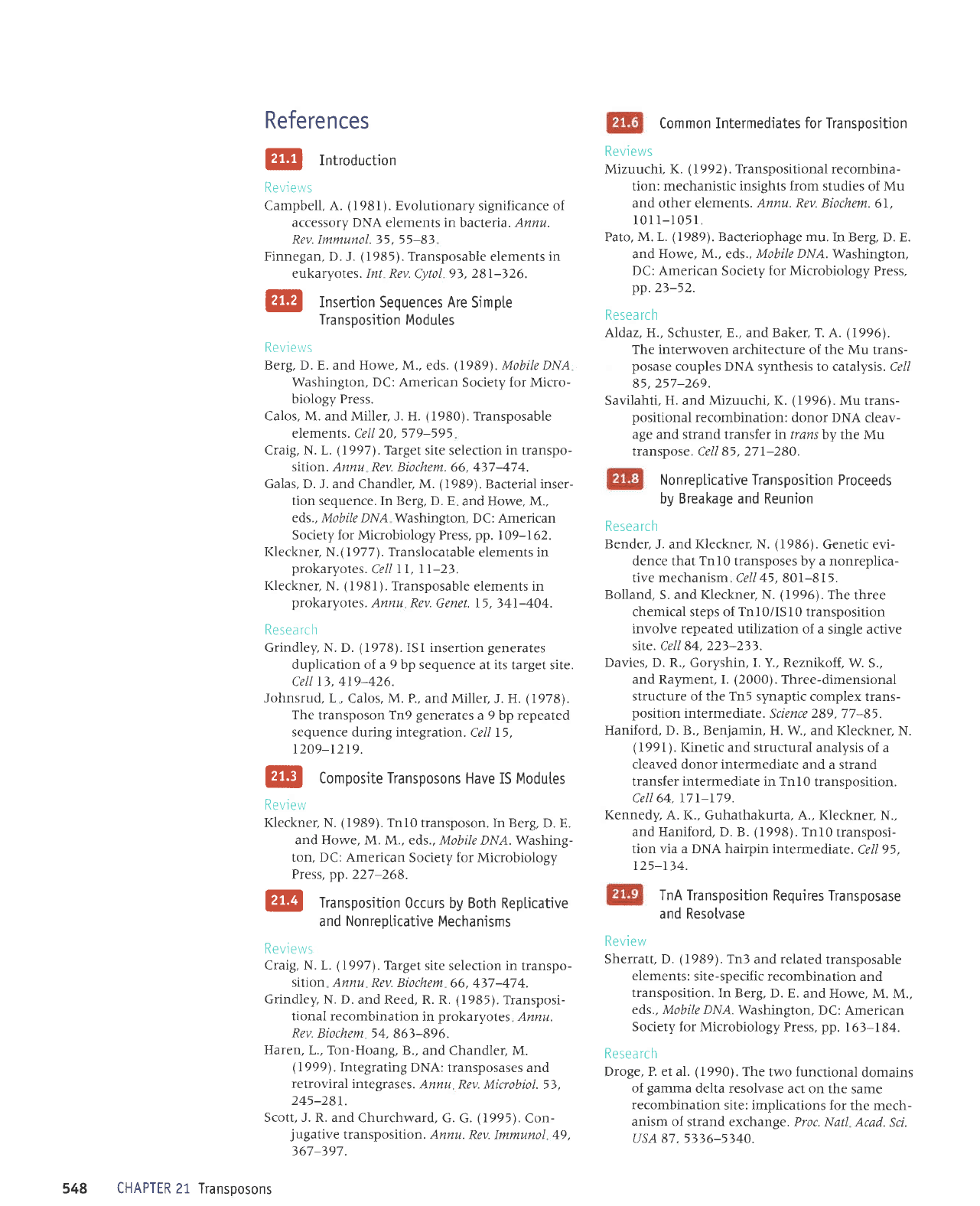
References
@
Introduction
Reviews
Campbell, A.
(
I98l
).
Evolutionary
significance of
accessory DNA
elements
inbacteria. Annu.
Rev. Immunol.
35,
55-83
Finnegan, D.
J.
(1985).
Transposable
elements
in
eukaryotes. Int Rev.
Cytol
9), 281-)26.
@
Insenron
sequences
nre
srmpre
Transoosition
Modules
Reviews
Berg, D. E. and Howe, M.,
eds.
(I989).
Mobile
DNA
Washington, DC: American
Society for Micro-
biology
Press.
Calos, M. and Miller, J. H.
(1980).
Transposable
elemenrs.
Cell
20, 579-595
Craig, N. L.
(1997).
Target
site selection
in
transpo-
silio}l. Annu Rey. Biochem.
66,
437 47 4.
Galas, D. J. and
Chandlea
M.
(1989).
Bacterial inser-
tion sequence. In Berg, D. E
and Howe, M.,
eds., Mobile DNA
Washington, DC: American
Society for Microbiology Press,
pp.
109-I62.
I(leckner,
N.( 1977). Ttanslocatable
elements in
prokaryotes.
Cell
ll, ll-23.
I(leckner,
N.
(1981).
Transposable
elements in
prokaryotes.
Annu Rev.
Genet. 15,341-404.
Resea
rc h
Grindley, N. D.
(1978).ISl
insertion
generates
duplication of a 9 bp sequence
at
its
target site.
Cell
13,
419-426.
Johnsrud, L
,
Calos,
M.
P., and Miller,
J.
H.
(1978t.
The
transposon Tn9
generates
a
9
bp
repeated
sequence during integration.
Cell 15,
t209-12r9.
t@
Composite Transposons
Have IS Modutes
KCVIEW
I(eckner,
N.
(1989).
Tnl0 transposon. In Berg,
D. E.
and Howe, M. M., eds., Mobile
DN,4. Washing-
ton, DC: American
Society for Microbiology
Press,
pp.
227-268.
Transposition
0ccurs
by
Both
Repticative
and
Nonrepticative
Mechanisms
Craig, N. L.
(19971.
Target site
selection in transpo-
silion
Annu Rev. Biochem
66,4)7-474.
Grindley,
N.
D.
and Reed, R. R.
(1985).
Transposi-
tional recombination
in
prokaryotes
Annu.
Rev. Biochem
54, 86)-896.
Haren,
L., Ton-Hoang,
B., and
Chandler, M.
(19991.
Integrating
DNA:
transposases and
retroviral
integrases.
Annu Rev. Microbiol.
5),
245-28t.
Scott, J. R. and
Churchward, G.
G.
(1995).
Con-
jugative
transposition. Annw.
Rev. Immunol 49,
367-J97.
CHAPTER 21 Transoosons
@
Reviews
Common
Intermediates for Transposition
Reviews
Mizuuchi, K.
(1992).
Transpositional
recombina-
tion: mechanistic insights from studies
of
Mu
and other elements.
Annu. Rev.
Biochem. 61.
l0I l-I051.
Pato,
M. L.
(
1989). Bacteriophage
mu. In Berg, D. E.
and
Howe, M.,
eds.,
Mobile DNA.
Washington,
DC:
American
Society
for Microbiology
Press,
pp.23-52.
Resea rch
Aldaz, H., Schuster, E., and Baker, T. A.
(1996).
The interwoven architecture
of the
Mu
trans-
posase
couples DNA synthesis
to catalysis. Cel/
85,257-269.
Savilahti,
H.
and
Mizuuchi, K.
(1996).
Mu trans-
positional
recombination: donor DNA
cleav-
age and strand transfer in trans
by the Mu
transpose. Cell 85, 27 l-280.
Nonrepticative Transposition
Proceeds
by Breakage and Reunion
Resea rch
Bender,
J. and
I{eckner,
N.
(I986).
Genetic
evi-
dence that
Tnl0
transposes by a nonreplica-
tive
mechanism
Cell
45,801-815.
Bolland, S. and Ifleckner, N.
(1996).
The
three
chemical steps of Tn I 0/IS I 0 transposition
involve repeated utilization
of a single active
site.
cell
84,223-2)3.
Davies, D. R.,
Goryshin,
L Y., Reznikoff,
W.
S.,
and Rayment, I.
(2000).
Three-dimensional
structure of the Tn5 synaptic
complex trans-
position
intermediate.
Science
289,
77
-85.
Haniford, D. B., Benjamin,
H. W, and I(leckner,
N.
(
I99 I
)
. I(netic and structural
analysis of a
cleaved donor intermediate
and a strand
transfer
intermediate
in Tnl0
transposition.
Cell 64, 17l-179.
I(ennedy,
A. I(., Guhathakurta, A., I(leckner,
N.,
and Haniford, D. B.
(1998).
Tnl0
transposi-
tion
via
a DNA hairpin intermediate.
Cell 95,
125-tj4.
TnA Transposition
Requires Transposase
and Resotvase
Review
Sherratt, D.
(1989).
Tn3
and
related
transposabie
elements:
site-specific recombination
and
transposition.
In Berg, D. E.
and Howe, M.
M.,
eds., Mobile DN,4.
Washington,
DC: American
Society for Microbiology
Press,
pp.
163-l
84.
Resea rc h
Droge, P. et al.
(1990).
The two functional
domains
of
gamma
delta resolvase
act on the
same
recombination
site: implications for
the mech-
anism
of strand exchange.
Proc. Natl Acad.
Sci.
usA 87, 5336-5340.
548
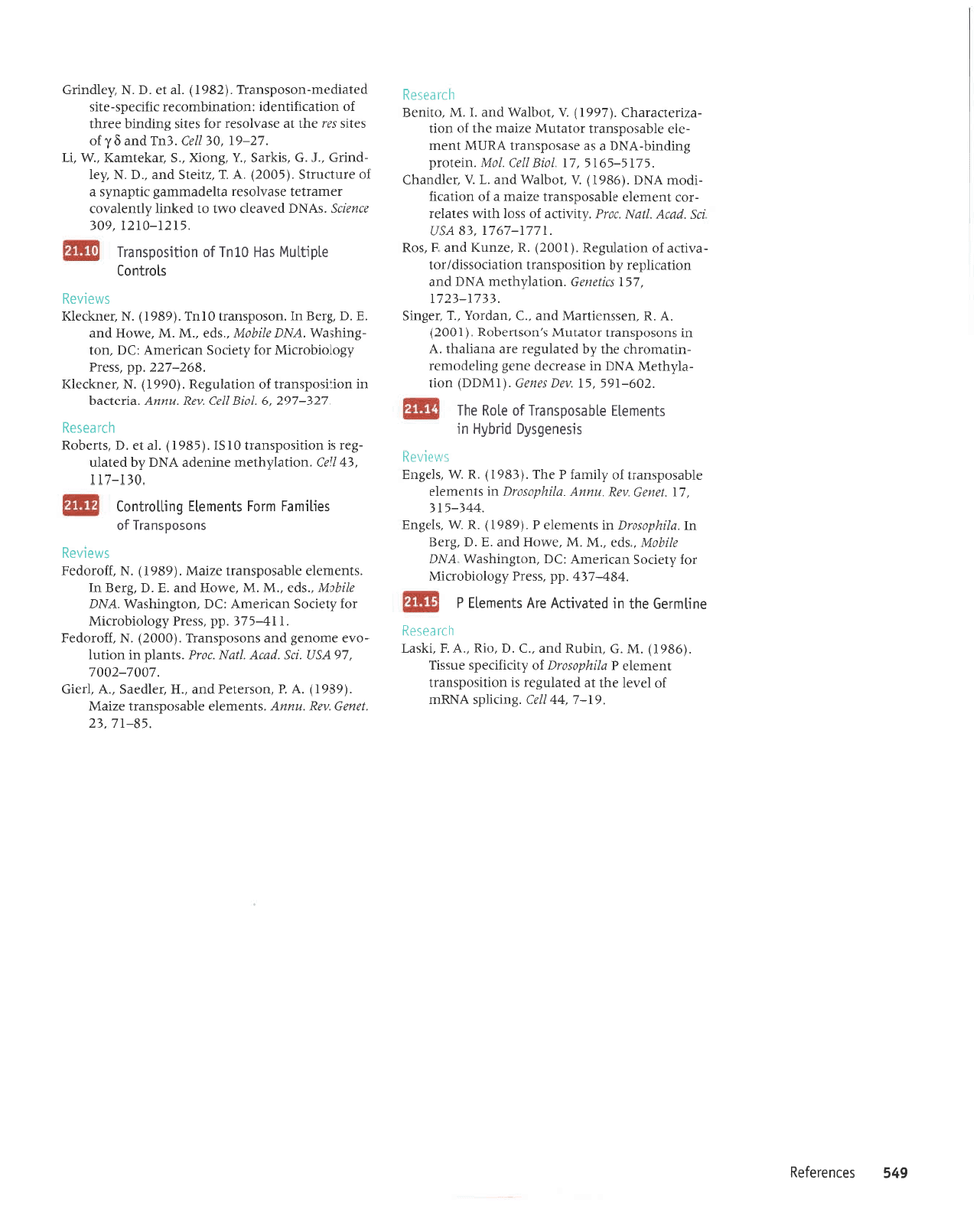
619
seluaralau
'
6t- L'11
//r)'EuDIIds
YNUUr
Jo Ie^al
aql
le
patelnEar
sr uorlrsodsuert
tuarrrelJ
d
DIu.ldosoJe
Jo
,{tlrlJlrads
anssU
'(SS0t)
'W'D 'ulqnU
pup
''f, 'O
'otU 'V'd
'l{se'I
qlr
Pasau
aurlrxls9
aql ur
pele^qlv
alv slueuell
d
'
VgV- Ltt'dd'ssar4
dEolorqonrry
ro; Ltarrog
up)rraruv :3q
'uolSurqseM
VNO
auqow'
spe
''14l 'w
'e,rroH
pue
'g 'q '3rag
ul ulu1dosotg
ur stuauele
d'(696I)
'g'14'sya8ug
'tt{-sr{.
'LI 'pua)
^aA
nuuv'altqdosotq
ur stuetualJ
alqesodsuerl
;o
,{.1ue;
d
aql
'(€g6I
)
g
'14 'sla8ug
sM0r^au
stsauabs^o
puq^H
ur
sluauall
elqesodsuprl
Jo
elo6 eql
'Z09-165'
tI'^ae
saaa,'
(
IWCC)
uorr
-e1^,{qtary
VNO
ul
rsper)ep aua8 Suqaporuar
-urlPruorqJ
aqr dq patepSar
are
puprTeql
'v
ur suosodsuelt
rotelnw s,uostJJqog
(tOOf)
'V 'U 'uJssuerlrew
pue
")
'uepro1 ''J
le8urs
,{-f
LI-fZ LT
'LSl
n\auag'uor1e1,{q13s1
VNq
pup
uorterrTdar,{q
uorlrsodsupJl
uorlpr)ossrp/rol
-plrlre
Jo
uorteln8aU
'(
t OOZ)
'U 'ezun>I
pup
C
'sog
'I
LLI-19
LI
'€8
VSN
ps
'pwv'lleN')oJd'.{tr.l,rlre
Jo
ssol
qlrM
salplar
-roJ
lueruela
alqesodsuerl
ezrevre
Jo
uorlpJlJ
-Iporu
vNo
'(ssot
)
A
'loqlpM
pup
'f .A 'rrlpueqf,
'SLIS-S9tS'
Lt
lolg ilD'tory'urarord
Eupurq-y1qq
e se esesodsuprt
VU1IN
tuaur
-a1a
alqesodsuprl
roletnw
azreu eqt
Jo
uorl
-pzlrel)preq)
'\L661)
.A 'toqlpM
pup
'I 'W 'olrueg
q
lr easa
u
'
sg-I L
'EZ
'
puaD'Aatr'
nuuv'sluawala alqesodsuprl Jzrew
'(OAOt) 'V
a
'uosreted
pup
''H
lelpaes
''V 'lrelD
'LOOL-T001
'
L6 VSn
'pS 'porv 'UDN
2ord
's1ue1d
ur uortnl
-oaa
auoua8
pue
suosodsuprl'(0002)'N'JJoropeC
'
I lt-S Lf.'dd'ssar4,(3o1orqonrry
ro;,{.lanog up)rreruv
:3q'uolSurqse6'yNO
altqow
"spa "W
'W 'e,r.t.oH
pup
'g 'q
'8reg
u1
'slueruela
alqesodsuerl azery
'(6961) 'N 'Jlorope{
sMarAau
suosoosuPrl
Jo
serlruel ulol
quauall
6ulliortuol
'0€
I-l,I I
'tV
tp)'uorle1.{qtau
auruape
y1qq,{.q pareln
-3ar
sr uortrsodsuerl
6191
'(SgOt)
'lp
ta
'C 'suaqou
qlr
Pasau
'
LZ€- L6Z' 9'
l0!g ila)
^aA' nuuv'Prretreq
ur uolllsodsuerl
;o
uorleln8ag
'(066I
)
'N
taDlrel>I
'g9Z-LZ.Z'dd 'ssar6
,{6olorqonryg
ro;,{1aoo5 upJlreruv
:)o
'uol
-3urqse14
'VNe
atlqow
''spa ''W 'W 'aMoH
pue
'g'q '3rag
u1
'uosodsuel
0IuI'(686I)
'N
trDpeDI
sMarAau
slorluol
aldqlnl/\l seH
0IuIJo
uorllsodsuelf
'stzvjrzt'60{.
nuans
'syNq
paleelr
o,lrl ot
pelull
dltuale.ror
reruerlel asplloser ellapeurueS
rrldeuds
e
Jo
arntrurs'(sOOz)
y';'zlfatS pue
''q'lrl
.{a1
-pulrD
''f 'D 'sr>lres 'a 'Euoty
"S
lplatlup>I
'.^^ 'IT
'
LZ-61
'0€.
tp)
'
€uI
pue
g
l.
yo
sJlrs .rrJ Jqt
lp
JspnlosJl
loJ sJlrs Sutputq :arqt
Jo
uonp)rJuuepr
:
uorleulqruora;
rt;trads-atts
prtprpeu-uosodsuell
'(ZSOy)'lp
ta
'61 '111
,(e1purr9
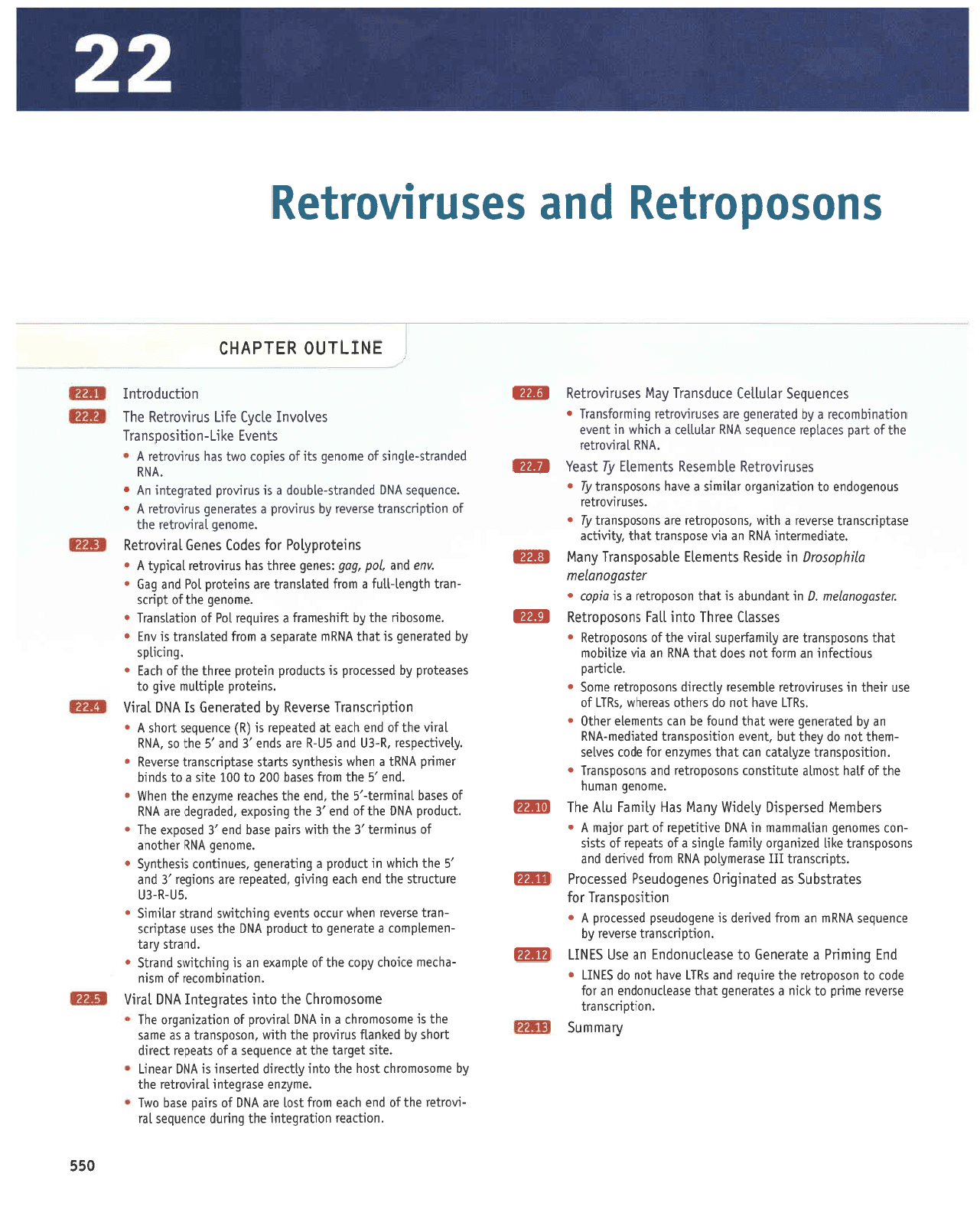
Aleuuns
'uorldulsuerl
aslo^or auud ol
lrru
e salpiauaE
leql
aspallnuopua ue loj
apor ol uosodorlal aql orrnba.l
pue
sull a^pq
lou
op
SINII
.
pul
bulrxud P alerauag ol aseallnuopul ue asn
slNIl
'uoqdursuerl
asranar
r{q
aluanbas
VNUur
up urol;
ponuep
sr ouabopnosd
pessarord
y
o
uorlrsodsuPrf roJ
salPrlsqns se
paleuL6ug
saua6opnasd
passelold
'sldursuerl
111
aseraur\1od
VNU
r.uo.U
pa^uap
pup
suosodsuPrl altl
paztuebto
r\1tue; e16uLs e
1o
sleede.r
Jo
slsts
-uol
saurouab uellpurrupur uL
ypq
anLlrladar;o
1ed
roletu
y
.
sraqu.raw
pasradsr0
flaptrtt Aue6
seg
A1rue1 n1y aq1
'euroueb
ueunq
oril
Jo Jleq
lsoulle
alnlrlsuor suosodorlar
pue
suosodsuerl
o
'uorlrsodsuerl
ezAleler
upl
lpql
sauAzua to1 apot sa^las
-ureql
lou
op Aaql
lnq
'lua^a
uorlrsodsuetl
polerpau-VNU
ue r{q
palereuab
etarrr
1eq1
punoj
aq upt s}uaulala ta{}Q
r
'sull
a^Pq
lou
op s.raqlo sealaqM
'sull
Jo
asn
ltoql ut sesn.lhorlar
alquasar r{11rarrp suosodollar aurog
o
'allt]le0
snorllaJur uP uiloJ
10u
saop
lPql
vNU
uP Pn azrlrqour
1eq1
suosodsuerl are Alrueyadns
letLn
aql
Jo
suosodorlaX
.
sasspll aelql
olur
llel
suosodoltau
Layso6ouopw'0 ur,
luepunqp
sr
1eq1
uosodorla.l e sr
prdo)
.
nlso6ouqaw
oTrqdosot1 ur aprsou
s1uauall alqpsodsuprl
fupW
'olerpoulalur
VNU
ue etn
asodsuerl
1eq1'Alnqre
oseldulsuprl asla^al
p
qlrn
'suosodorlar
are suosodsue4
f1
t
's0snr!A0rlal
snouaEopuo o1 uoqezruebro lpllrxrs
e aneq suosodsue4
t1
t
?r-r7
IJ-.72
1T-.r2
@
@
sesnrnorlau
alquasau
quauall
f1
1sea1
@
'vNu
lerho.llar
aq1
1o
1ed
salpldal aruanbas
VNU
telnllar e
qltqm
u!
lua^a
uorlpurqurolar e Aq
paleraua6
arp sesnrhorlel 6urruro;suel1
o
saluanbas lelnllel
alnpsuelf
Ae6
sasnrrnorlaX
Gf,rl
099
'uorllpal
uorlerbelut
eq1 6uunp aluanbas
lpl
-|.^ollal
oqlJ0
pua qlea
uolJ
1s0l
ale
VNo
Jo
sltPo asPq o/vU
'auAzua
ase:6e1ut
lerr^orlal
eql
r{q
auosouorql
}soq
aql olut
nl}rartp
poilasur
st
VNg
rpaut"l
'alrs
labrpl
eq1
1e
aruanbes
p
Jo
sleodol
palp
loqs
Aq
paIUplJ
snr!^old
eql
qllm
'uosodsuell
P se aulPs
eql sr aujosoruo.lqr e
ut
ypq
lernord
1o
uotleztue6to
aqg
auosotxolql
aql olut selelDalul
vN0
lPrlA
'uorlPurquola.l
J0
urslu
-eqlau
alroql
Ador eq1;o alduPxa ue
sL butqrluvrs
puel|$
o
'puetls
&e1
-uaurelduror p
alprauab
o1
lrnpord
VN0
aql sasn aseldurs
-uPrl
osia^al uaqM
rnllo sluaaa 6uLqrlLMs
puPlls
.lPltult$
o
'9n-u-€n
alnllntls
eql
pua qlPa
6unr6'peleedar
a.re suo16al,g
pue
,9
aql
qrlqM
ur
pnpord
e 6uqPleua6
'sanutluol
sLsaqlur\5
o
'auouaD
vNU
raqloue
Jo
snurural,€ aql
q}!M
slrPo asPq
pua
/€
pes00x0
aql
.
'1rnpo.rd
VN6
aqt
Jo
pua
,E
aql butsodxa
'papetbep
ale
VNU
jo
seseq
lpurulal-,g
aql'pue
aql saqtpar au^zua a{} ua{i\r\
r
'pue
/9
eql uol] soseq
002
ol
00I
alts P ol sputq
rauud
ypXl
e uaqM srsaqlur\s silels
eseldursuerl osraAa!
r
'AlarLlredsar'U-€n
pup
En-U
arp spua,€
pue,g
aql 0s'VNU
lprrn
aql
Jo
pua qlpa
1e
paleadar
sr
(6)
aruanbas
!o!s
!
r
uoqdulsuerf
esle^au
Aq
palerauag
sI
VNo
leltA
'surelord
aldqlnu anr6 o1
sasealold
l\q
passerord
sr slrnpord uralotd
earql aql
Jo
qlpl
.
'6utctlds
Aq
paleraua6
sr
leql
VNUr.u
aleredas
e uror1
palplsuerJ
sr AUI
e
'auosoqu
aq1
r{q
grqsaue.rl
e satLnbar
lod Jo
uot}PlsuPrl
.
'auoua6
aq1
1o
ldurs
-uer1
q16ua111n;
e urorJ
palplsupll
ale suralord
1o6
pue
6eg
.
'^ua
pue
'pd '606:saua6
aarql seq
snrhollar
lerrd^l
y
r
surelordflod
roJ sapol sauag
lPr^orlau
'auroue6
lPlr^oller
eql
jo
uorldulsuprl
eslalai r{q snrrnold e saletauab
snrtnorlol
V
'aruanbas
vN0
pepuPlls-alqnop
e sr snrnord
peler6alur
uy
'VNU
papuerls-albuls
lo
auouab
s1r;o satdor oml serl snr! ollar
v
a
a
slua^l 0lrl-uolllsoosuell
sa^lo^ul allfl aJrl snrnorlau aql
uoqlnp0llul
SNrtrn0 u31dvH3
suosodojleu
pue
sesnJ.lnorleu
